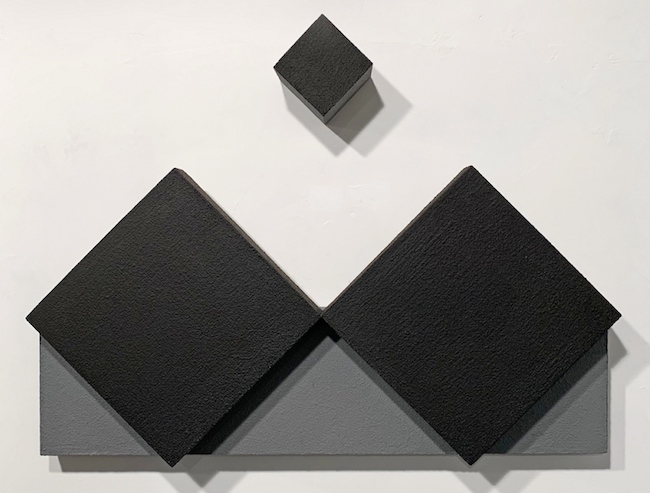I ritmi frenetici che contraddistinguono il vivere contemporaneo spingono molti creativi a cercare una dimensione differente, quella in cui costruire e dar vita a un mondo slegato dalla contingenza, in cui tutto possa avere un senso diverso, quello della calma e della tranquillità fine a se stessa, che non porti in alcun dove piuttosto induca l’osservatore a fermarsi e stazionare all’interno di quella realtà parallela e quasi rassicurante rispetto alla realtà. Alcuni tra questi artisti scelgono l’universo dell’astrazione totale, quella in cui lo sguardo non riconosca forme note bensì si lasci travolgere dalla pura emozione, altri invece sentono la necessità di definire dei confini, di mettere in ordine e determinare tutto ciò che spesso invece è in disordine, lasciando proprio alla schematicità il compito di infondere un senso di pace. Il protagonista di oggi appartiene a questa seconda categoria di artisti e riesce a trasformare l’Astrattismo Geometrico in magnifico nuovo mondo in cui rifugiarsi per ascoltare un silenzio di cui si è dimenticato il suono.
Il distacco con l’arte tradizionale si verificò in modo graduale a partire dalla fine dell’Ottocento con l’Impressionismo prima e l’Espressionismo e il Divisionismo poi, dopodiché quel processo di rinnovamento subì una brusca accelerazione e si concretizzò fin dagli esordi del Ventesimo secolo attraverso movimenti radicali, estremi perché determinati a dare un senso inedito all’atto creativo e alla generazione di un’opera d’arte. Le correnti più estremiste furono quelle che diedero seguito alla teoria di scomposizione dell’immagine iniziata con il Pointillisme di George Seurat e di Paul Signac in cui il colore era suddiviso in piccoli punti che solo da lontano riuscivano a dare il senso generale di quanto riprodotto, continuata con il Divisionismo di Giovanni Segantini, ancora fortemente legato a un approccio più aderente alla realtà, con il Futurismo di Filippo Tommaso Marinetti e di Giacomo Balla che scompose letteralmente l’osservato in forme geometriche che associate e ripetute infondevano nell’osservatore il senso del movimento. Da quel primo esperimento si generò l’ulteriore sperimentazione del Cubismo, ancora legato alla figurazione, ma anche una posizione di distacco dall’attinenza a tutto ciò che lo sguardo conosceva per entrare nel mondo dell’Astrattismo che ben preso trovò la sua massima espressione, per la purezza che gli artisti che vi aderirono davano al gesto plastico fine a se stesso, nel Suprematismo di Kasimir Malevic, nel De Stijl di Piet Mondrian e nell’Astrattismo Geometrico. Secondo le linee guida di queste correnti l’arte non doveva essere contaminata dalla soggettività, dall’emozione, bensì affermare la sua sussistenza a prescindere dall’osservato, dal percepito, perché era solo attraverso il distacco dalla realtà che poteva rendere tangibile la perfezione di un atto creativo fine a se stesso. Negli anni seguenti questi temi furono sviluppati e amplificati dal Minimalismo e dallo Spazialismo, movimenti in cui ciò che cominciava a diventare rilevante oltre alla superficie della tela era anche la sua interazione con lo spazio circostante, quel voler rappresentare anche la terza dimensione lasciandola entrare con il gesto dello strappo dello Spazialismo di Lucio Fontana, in cui pertanto entrava in gioco anche l’azione, o cercandola all’esterno attraverso le estroflessioni di Enrico Castellani e Agostino Bonalumi o le illusioni ottiche e dimensionali delle sculture di Robert Morris, che aprì di fatto la strada all’universo delle installazioni.
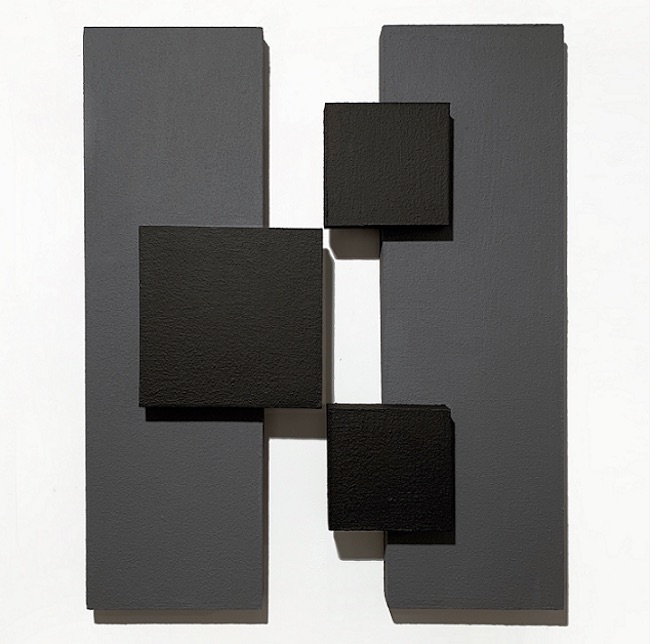
La ricerca che contraddistingue l’artista milanese Stefano Paulon si collega all’Astrattismo Geometrico ma si spinge anche verso il mondo dello spazio come elemento necessario a esplorare il silenzio che circonda l’equilibrio esecutivo, quella modalità intimista attraverso la quale è possibile allontanarsi dal rumore esterno, o quello dei propri pensieri, e trovare un luogo non luogo in cui sospendersi; paradossalmente, malgrado i movimenti legati alla geometricità e all’astrazione imponessero un distacco dalla sfera emozionale, le opere di Paulon sembrano al contrario immerse nella sensazione, nella suggestione di un mondo ideale dove tutto appare in ordine, determinato, senza le sorprese, le destabilizzazioni e le insicurezze del vivere contemporaneo.
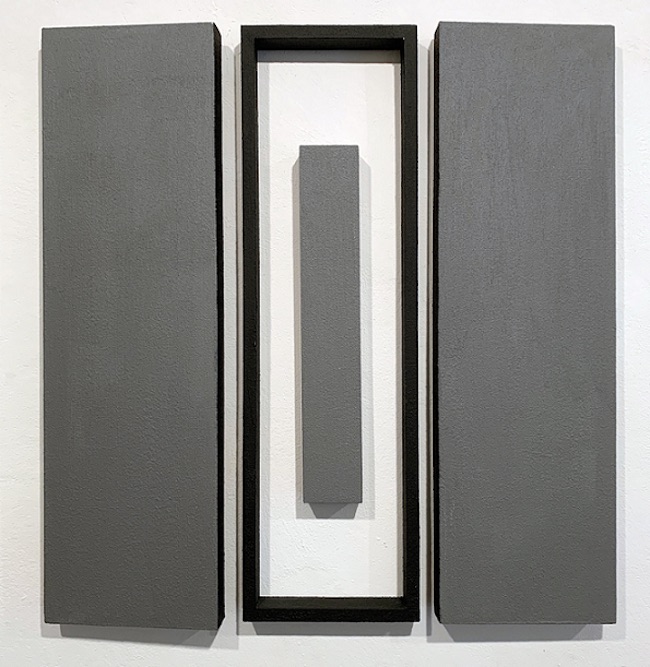
La gamma cromatica scelta sembra essere quella più affine alla creazione del luogo in cui l’artista trasporta se stesso ma anche l’osservatore, proprio perché neutra, lineare, rassicurante nella sua rigorosità affiancata a un’inaspettata morbidezza visiva, dunque bianco, nero e grigio che, affiancati gli uni agli altri contribuiscono a implementare il senso del volume, di luce e ombra, di quei piani che sembrano uscire dalla tela per guadagnare un piccolo spazio intorno a sé, quasi come se fossero metafora dell’individuo che costantemente, e spesso timidamente, tenta di trovare la propria dimensione all’interno di una società spesso alienante.
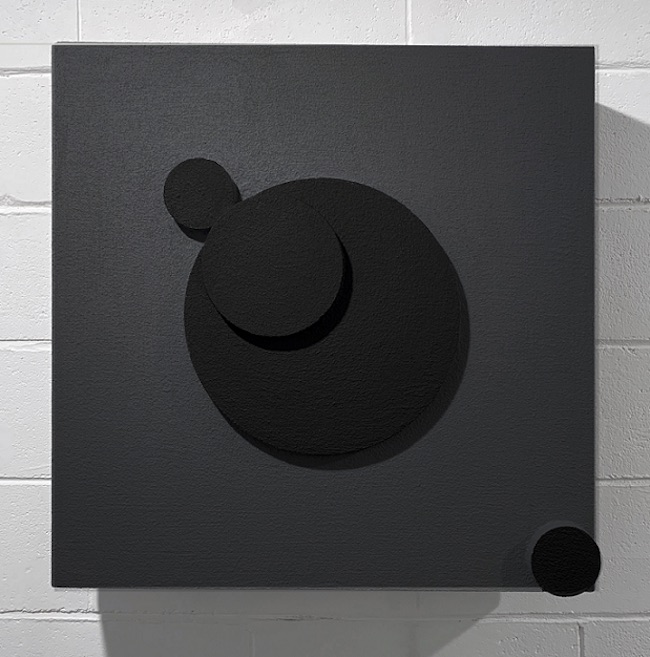
Le opere di Paulon al contrario e malgrado la formale rigidità geometrica, appaiono inclusive, accoglienti, proprio per quel loro evocare un silenzio dentro il quale lasciar fluire liberamente le sensazioni e le emozioni che non vengono contrastate dal rigore, piuttosto se ne sentono protette. Il quadrato, il rombo, il cerchio, il parallelepipedo vengono dislocati nella superficie della tela in maniera ragionata, come se ogni millimetro fosse funzionale a infondere una rassicurante stabilità, un’armonia che gradatamente conquista in maniera quasi magnetica lo sguardo fino a indurlo a perdersi nella suggestione creata da Stefano Paulon, quella che con i suoi echi conduce verso una riflessione aperta su tutto ciò che spesso sfugge all’occhio distratto dell’uomo contemporaneo il quale in virtù dell’assenza di elementi distraenti può mettersi nella condizione di ascoltare l’invisibile.
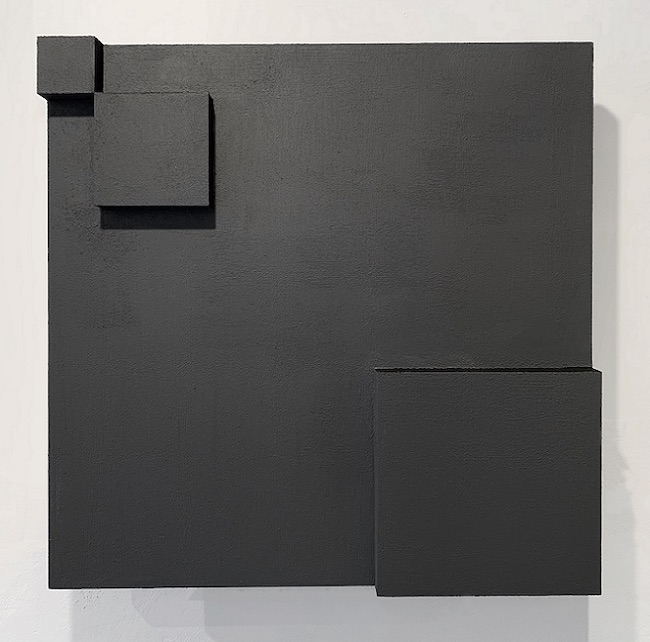
Ciò su cui si focalizza l’attenzione dell’artista è l’importanza delle opposizioni, quell’alternarsi di positivo e negativo, di pieno e vuoto, di essenza e di sostanza che divengono metafora della civiltà moderna, la quale mostra le sue apparenti forze e le sue innumerevoli debolezze proprio in quell’incapacità di mantenere il contatto con l’interiorità, con la sensibilità necessarie all’essere umano per non perdere il contatto con il sé più profondo; ecco quello di Paulon sembra essere un invito costante a sedersi e restare lì, a meditare sui volumi che escono dallo spazio della tela e che sono associabili a pensieri, ricordi, idee che solo in quella dimensione sospesa riescono a riaffiorare.
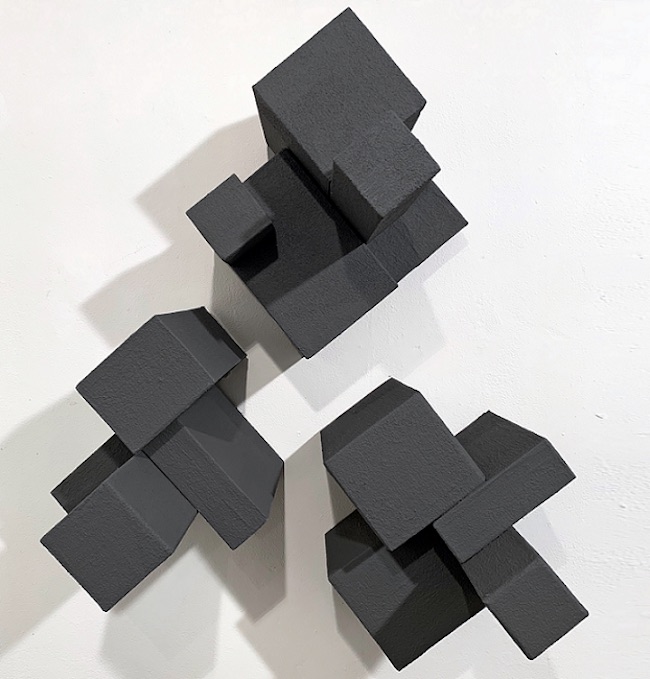
Sceglie di non dare titoli alle sue opere bensì denominarle solo con la sigla del suo nome seguita da un numero perché desidera lasciare al fruitore la libertà intellettuale ed emozionale di interpretare, o ascoltare, il messaggio che fuoriesce dall’immobilità dell’immagine, come se rispettasse il momento di silenzioso raccoglimento di ciascuno senza dare una traccia che costituirebbe una sua personalizzazione; in questo dimostra e conferma la sua apertura, il suo bisogno di stimolare l’introspezione sospendendo il giudizio, non dando la sua opinione bensì socraticamente indurre l’osservatore a porsi quelle domande che riescono a emergere solo in condizione di astrazione dal contesto circostante.
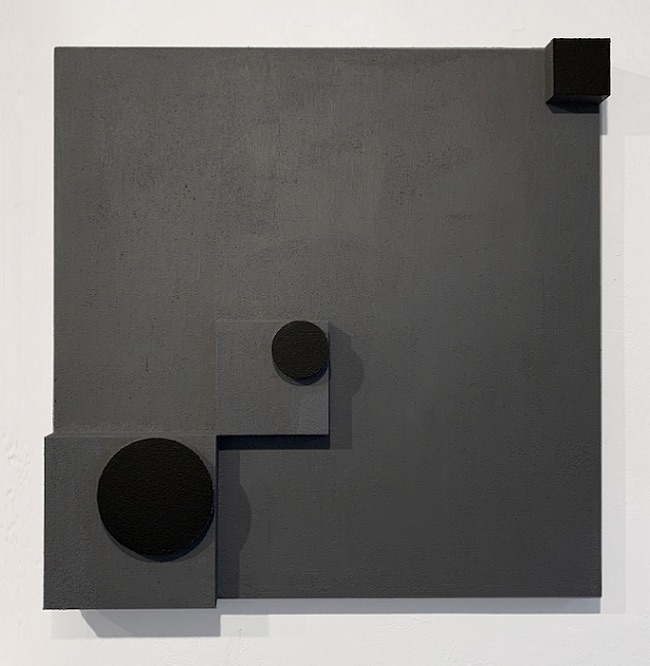
L’opera SP25092 sembra la rappresentazione dell’eco, quello della memoria, quello delle emozioni vissute che pur allontanandosi non smettono di far sentire la loro voce, ed è la forma del cerchio quella scelta per rappresentarlo, della rotondità che sottintende la compiutezza, l’eterno ritorno ma anche il completamento di un’essenza che non può prescindere da tutto ciò che ha fatto parte del passato diventando base per il presente.
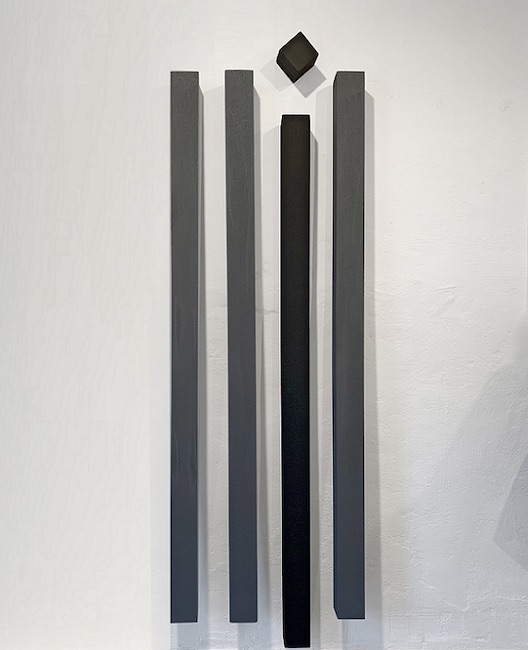
Tanto quanto SP36033 costituisce un invito a considerare gli eventi nella loro unicità, come se fossero tasselli consecutivi funzionali a comporre e dare un senso all’esistenza ma che molto spesso non vanno paragonati o temuti nella loro ripetitività poiché ogni attimo, ogni episodio, è irripetibile; questo è il motivo per cui le linee sono nettamente separate, costituiscono un istante distinto dai seguenti mentre insieme conducono l’individuo verso il passo più importante, quello che costituisce il raggiungimento dell’evoluzione a cui ciascuno tende. Pittura, scultura, disegno e poesia sono i mezzi espressivi con cui Stefano Paulon si misura, per mezzo dei quali si interroga e ricerca le parziali verità che possono essere sovvertite un istante dopo da nuove consapevolezze proprio in virtù di quel suo costante tendere verso la sperimentazione, la trasformazione del suo stile come di se stesso. Stefano Paulon ha al suo attivo la partecipazione a molte mostre collettive e personali presso realtà istituzionali sia pubbliche che private, e ha recentemente iniziato la catalogazione del suo percorso artistico ai fini della creazione dello Stefanopaulonarchive.
STEFANO PAULON-CONTATTI
Email: press@stefanopaulon.it
Sito web: www.stefanopaulon.it
Facebook: www.facebook.com/stefanopaulon
www.facebook.com/stefanopaulonarchive
Instagram: https://www.instagram.com/stefanopaulon/
Linkedin: https://www.linkedin.com/in/stefanopaulon/
The search for perfect balance in the geometric forms of Stefano Paulon, between light and shadows of silence
The frenetic rhythms that characterise contemporary life drive many creatives to seek a different dimension, one in which they can construct and give life to a world detached from contingency, in which everything can have a different meaning, that of calm and tranquillity for its own sake, one that does not lead anywhere but rather induces the observer to stop and station himself within that parallel and almost reassuring reality. Some of these artists choose the universe of total abstraction, one in which the gaze does not recognise known forms but rather allows itself to be overwhelmed by pure emotion. Others, instead, feel the need to define boundaries, to put in order and determine everything that is often in disorder, leaving precisely to schematicity the task of instilling a sense of peace. Today’s protagonist belongs to this second category of artists and succeeds in transforming Geometric Abstractionism into a magnificent new world in which to take refuge and listen to a silence whose sound has been forgotten.
The detachment from traditional art occurred gradually from the end of the 19th century first with Impressionism and then Expressionism and Divisionism, after which that process of renewal underwent an abrupt acceleration and materialised from the beginning of the 20th century through radical movements, extreme because they were determined to give a new meaning to the creative act and the generation of a work of art. The most extreme currents were those that followed the theory of decomposition of the image begun with the Pointillisme of George Seurat and Paul Signac in which colour was broken down into small dots that only from a distance could give the overall sense of what was being reproduced, continued with the Divisionism of Giovanni Segantini, still strongly linked to a more adherent approach to reality, with the Futurism of Filippo Tommaso Marinetti and Giacomo Balla who literally broke down the observed into geometric shapes that associated and repeatedly infused the observer with a sense of movement. From that first experiment came the further experimentation of Cubism, still linked to figuration, but also a position of detachment from everything that the eye knew in order to enter the world of Abstractionism, which soon found its highest expression, due to the purity that the artists who adhered to it gave to the plastic gesture for its own sake, in Kasimir Malevic’s Suprematism, Piet Mondrian’s De Stijl and Geometric Abstractionism.
According to the guidelines of these currents, art was not to be contaminated by subjectivity, by emotion, but rather to assert its subsistence regardless of the observed, the perceived, because it was only through detachment from reality that it could make tangible the perfection of a creative act as an end in itself. In the years that followed, these themes were developed and amplified by Minimalism and Spatialism, movements in which what began to become relevant in addition to the surface of the canvas was also its interaction with the surrounding space, that desire to represent even the third dimension by letting it enter with the gesture of Lucio Fontana’s Spatialism, in which therefore action also came into play, or by seeking it outside through the extroversions of Enrico Castellani and Agostino Bonalumi or the optical and dimensional illusions of Robert Morris’s sculptures, which in fact opened the way to the universe of installations. The research that distinguishes the Milanese artist Stefano Paulon is connected to Geometric Abstractionism, but also pushes towards the world of space as a necessary element to explore the silence that surrounds executive equilibrium, that intimist mode through which it is possible to distance from external noise, or that of one’s own thoughts, and find a non-place in which to suspend oneself; paradoxically, despite the movements linked to geometricity and abstraction imposing a detachment from the emotional sphere, Paulon’s artworks seem on the contrary to be immersed in sensation, in the suggestion of an ideal world where everything appears in order, determined, without the surprises, destabilisations and insecurities of contemporary living.
The chromatic range chosen seems to be the one most akin to the creation of the place into which the artist transports himself but also the observer, precisely because it is neutral, linear, reassuring in its rigorousness flanked by an unexpected visual softness, hence white, black and grey which, placed side by side, contribute to implement the sense of volume, of light and shadow, of those planes that seem to come out of the canvas to gain a little space around them, almost as if they were a metaphor for the individual who constantly, and often timidly, tries to find his own dimension within an often alienating society. Paulon’s artworks, on the contrary, and in spite of their formal geometric rigidity, appear inclusive, welcoming, precisely because they evoke a silence within which sensations and emotions can flow freely; they are not thwarted by rigour, rather they feel protected by it. The square, the rhombus, the circle, the parallelepiped are placed on the surface of the canvas in a reasoned manner, as if every millimetre was functional to instil a reassuring stability, an harmony that gradually conquers the gaze in an almost magnetic manner until it is lost in the suggestion created by Stefano Paulon, the one that with its echoes leads towards an open reflection on all that often escapes the distracted eye of contemporary man, who by virtue of the absence of distracting elements can put himself in a position to listen to the invisible. What the artist focuses on is the importance of oppositions, that alternation of positive and negative, of full and empty, of essence and substance that become a metaphor for modern civilisation, which shows its apparent strengths and its innumerable weaknesses precisely in that inability to maintain contact with interiority, with the sensitivity necessary for human beings not to lose contact with their deepest selves; so, that of Paulon seems to be a constant invitation to sit and stay there, to meditate on the volumes that emerge from the space of the canvas and that are associated with thoughts, memories, ideas that only in that suspended dimension manage to resurface. He chooses not to give titles to his artworks but only denominate them with the initials of his name followed by a number because he wishes to leave the viewer with the intellectual and emotional freedom to interpret, or listen to, the message that emerges from the stillness of the image, as if respecting the moment of silent recollection of each one without giving a trace that would constitute his personalisation; in this he demonstrates and confirms his openness, his need to stimulate introspection by suspending judgement, not by giving his opinion but by Socratically inducing the observer to ask himself those questions that can only emerge in a condition of abstraction from the surrounding context.
The artwork SP25092 seems to be the representation of the echo, that of memory, that of experienced emotions which, although receding, do not cease to make their voice heard, and it is the shape of the circle that has been chosen to represent it, of the roundness that implies completeness, the eternal return but also the completion of an essence that cannot disregard everything that has been part of the past, becoming the basis for the present. As much as SP36033 constitutes an invitation to consider events in their uniqueness, as if they were consecutive pieces functional to compose and give meaning to existence but which very often should not be compared or feared in their repetitiveness since each moment, each episode, is unrepeatable; this is why the lines are clearly separated, constituting an instant distinct from the following ones while together they lead the individual towards the most important step, the one that constitutes the achievement of the evolution to which each one tends. Painting, sculpture, drawing and poetry are the expressive means by which Stefano Paulon measures himself, by means of which he questions himself and searches for partial truths that can be subverted an instant later by new awarenesses precisely by virtue of his constant tendency towards experimentation, the transformation of his style as well as of himself. Stefano Paulon has participated in many group and solo exhibitions at both public and private institutions, and has recently begun cataloguing his artistic career for the purpose of creating the Stefanopaulonarchive.


